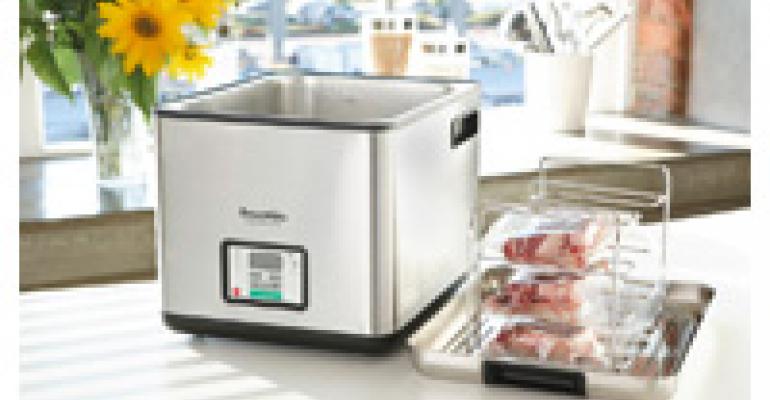
Thomas Keller wrote a book about it, molecular gastronomists around the world sang its praises and trendwatchers galore were positive that 2009 was the year sous vide cooking finally would take off. Appliance makers even began marketing home sous vide units for enthusiasts who wanted to try it for themselves. So what happened? Well, we’re still waiting.
It’s strange that Keller couldn’t light a fire under the sous vide market. Not only is the guy the country’s most-lauded chef, with high-profile locations on both coasts. He’s also a powerhouse seller of cookbooks. Yet if you look up his book’s sales rank on Amazon.com…let’s just say he probably won’t be doing a sequel to his sous vide book anytime soon.
And if the Keller connection isn’t trendy enough for you, consider what ace molecular gastronomist Grant Achatz, who relies heavily on sous vide cooking, has done. Anyone can go to YouTube.com and watch Achatz—who won the James Beard Award in 2009 as the country’s best chef—demonstrate how to cook an entire Thanksgiving turkey sous vide-style. Most people who’ve previously gone the deep-fried turkey route have to be thinking that the Achatz approach sure looks like the better way to go.
Sous vide is held in particularly high regard in Europe. Check out this ringing endorsement of a sous vide device—in his case, the Clifton Food Range Water Bath designed for commercial kitchens—from Stephane Jouan, executive chef at the Harbour Heights hotel in Poole, England:
"Our first Water Baths were delivered in 2006, and now 90% of all our menu items are produced using the sous vide method. This covers all sections of the kitchen and all meal times, from scrambled eggs for breakfast through lunch and dinner for dishes like Chicken Supreme and lamb rump. The results truly are 100% accurate every time. There is a huge improvement in taste and texture across the board, particularly when cooking fish. Stress levels in the kitchen have been reduced, I have more time to train junior chefs and we now have more time for service and can ensure everything goes out perfectly right. Energy costs have been significantly reduced and this combined with less wastage means our GP (gross profit) has risen between 10-12%.”
Boy, who wouldn’t want something that can do all that? Which is why sous vide has so many hard-core fans among those who work in professional kitchens. But the chefs who employ this method inhabit the upper reaches of the culinary stratosphere. It could be that sous vide device manufacturers have perfected a method to prepare food in a segment—fine dining—that’s shrinking as we speak.
Maybe the sous vide approach will catch on at home. That’s what the makers of the SousVide Supreme unit hope. Their pitch demystifies the process with a crystal-clear description:
“The concept of sous vide is to cook the food at the same temperature you wish it to be served; most dishes should cook between 120°–190° Fahrenheit (48.9°–87.8° Celsius). The key to sous vide is maintaining the same water temperature throughout the entire cooking process, as a difference of only one degree can change appearance, flavor and texture.”
Which is the primary reason to fork over $399 for the SousVide Supreme Water Oven. You want reliability and pinpoint calibration at all costs. But how fast does food cook in it?
“Cooking times range from as little as 20 minutes for delicate dishes such as fish, to up to 72 hours to tenderize tougher meats or to create spare ribs that fall off the bone. However, one of the major advantages of the sous vide style is that food can be left in the water bath for much longer than the minimum time and will remain perfectly cooked until the moment they are served.”
It sounds like the home cook can’t miss with sous vide, and it’s no wonder the trendmeisters thought 2009 was the year it was finally going to take off both in restaurants and in home kitchens. So what happened?
We think the answer can be found in SousVide’s Supreme five-step mantra: “Season. Seal. Simmer. Sauce and Sear. Serve.” We don’t know the home cooking market like the SoudVide Supreme marketers do, but they sure are making it sound like a lengthy, time-consuming process.
This line in particular points out the potential complexity of the sous vide cooking process: “Before serving, meat dishes are typically also seared in a hot pan for a few minutes, to create a traditional appearance and outer flavor.” Great, but why bother with the sous vide part of the process if you’re going to throw the product in a hot pan anyway and then sauce it, to boot? Generally speaking, we think a device that makes home cooking slower and more complicated may not catch on as fast as its makers hope.
Sous vide cooking has been around for decades, and it makes a lot of sense for many cooking situations, particularly in some professional kitchens. It’s a godsend for high-end banquets, to be sure. But if you’re hoping that a new wave of sous vide-crazy home cooks will drive new business into the restaurants of the sous vide masters like Keller and Achatz that wills spill over into a place like yours, you might have a long wait.





